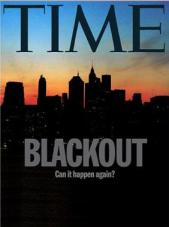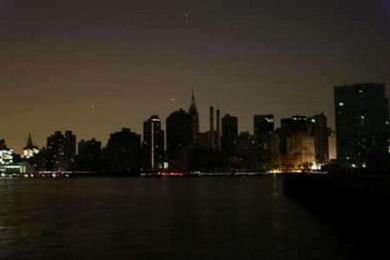Categories: Featured Articles » Interesting Facts
Number of views: 54862
Comments on the article: 1
How the end of the world came in the USA
 In the United States, the end of the world was already - in August 2003. It all started on August 14, at 16:10 Eastern time, the same for parts of the USA and Canada. It was at this hour that the recording instruments in the energy ring surrounding Lake Erie (one of the five Great Lakes) recorded the first deviation from the norm: three power lines in northern Ohio failed. In the next three minutes, voltage was removed from several dozen lines, 21 power plants were decommissioned, and the vast territory that covered part of North America, including pieces of the USA and Canada, was left without electricity. According to various estimates, from 30 to 50 million people were in the disaster area. The Western press unanimously dubbed the incident "the largest energy accident in the history of North America."
In the United States, the end of the world was already - in August 2003. It all started on August 14, at 16:10 Eastern time, the same for parts of the USA and Canada. It was at this hour that the recording instruments in the energy ring surrounding Lake Erie (one of the five Great Lakes) recorded the first deviation from the norm: three power lines in northern Ohio failed. In the next three minutes, voltage was removed from several dozen lines, 21 power plants were decommissioned, and the vast territory that covered part of North America, including pieces of the USA and Canada, was left without electricity. According to various estimates, from 30 to 50 million people were in the disaster area. The Western press unanimously dubbed the incident "the largest energy accident in the history of North America."
America really still did not know anything similar in scale. Huge traffic jams (traffic lights do not work), metro that got up, stopped plants, factories, shops, quiet offices. Canceled and delayed departures from all civilian airports in the disaster area (although they say that it’s only because of the disconnected equipment for monitoring passenger traffic to identify potentially dangerous persons and objects - the dispatch equipment worked from its own sources of electricity).
Helpless and useless mobile phones: networks of Sprint, Verizon, Nextel and many other companies, which were tightly clogged with a four-fold burst of user activity in the first hours of the accident, quickly died, because base stations have only 6-hour battery life from backup batteries. Abused in stores where even ice is bought up. Separate cases of looting and unrest - fortunately, the police, military and rescue services operated.
It is interesting that despite the huge number of people and organizations that got into the “dimming”, the Network’s work in the USA went in normal mode: AOL noted only a small decrease in the number of clients connected to modem pools at once (from the usual 2.4 to 2.1 million), backbone networks and important Internet sites functioned seamlessly (Keynote Systems data).
Why and how did this happen? There is no definite answer to this question - just guesses. Modern electric power systems are a very complex complex, the management of which involves not only launching a generator at a power plant and connecting it to a consumer, but also taking into account many thousands of features and monitoring hundreds of processes associated with electric power transmission.
Incorrect or untimely (and the so-called transient processes on transmission lines take place in a split second), the reaction to certain events is fraught with very serious consequences, including physical damage to equipment. So, for example, a partial break in the transmission line can lead to a voltage jump at its ends several times, which is equally dangerous for the consumer, and for the electricity supplier, and for the owner of the line itself. The matter is further complicated by the fact that an accident that occurred in one area causes an avalanche effect, spreading to neighboring ones.
Of course, to prevent such accidents, there is a special alarm and automation - and it is precisely this technique that residents of the remaining electrified parts of the American continent owe their salvation to: on time, triggered devices separated the emergency part of the electric network from the still functioning one. But the same automation, standing at the junction of networks (electric networks in the USA and Canada is private property), not properly debugged, seems to be to blame for the fact that as many as two dozen power plants fell into the disconnection zone.

Natural, large-scale, avalanche-like outages are a real scourge of the American electric power industry. These accidents spread lightning fast in a matter of minutes, and despite the creation of special regulatory authorities (such as NERCs that unite many individual small networks), they have been harassing the United States for the past 50 years. Particularly recall the case of 1965, when 30 million people were left without light (Great blackout - Great blackout), and the shutdown of 1977, as a result of which New York survived a night of horror, falling victim to thousands of marauders, rapists and murderers. All these and many other similar accidents occurred in a maximum of ten minutes, while the restoration of normal operation of the electric network usually takes several days (the current case is no exception).
Why? Imagine a system that includes dozens of power plants, transmission lines and thousands of consumers. Returning it to life after disconnection and disconnection, first of all, it is necessary to synchronize the various parts, guaranteeing the identity of the parameters of electric energy (voltage, frequency) in them. It should be remembered that in some parts of the system, the load (customer needs for electricity) can be many times greater than the capacity of local power plants (after resuming collaboration, they are helped by stations in neighboring territories).
It’s impossible to force customers to voluntarily limit their electricity consumption, which is why power engineers resort to forced partial blackouts: it is precisely because of them that a number of enterprises are idle today and many residential areas of the USA are deprived of light.
There are many assumptions regarding the amounts into which all this doomsday will pour out, and they vary over a very wide range. Assuming industrial production, retail, and the shipping industry are generally affected, some analysts predict losses of up to one billion dollars for each state that is cut off. And this is the bottom line.
See also at bgv.electricianexp.com
:

